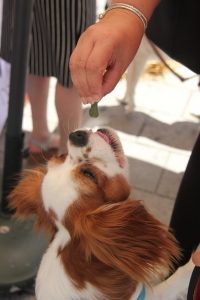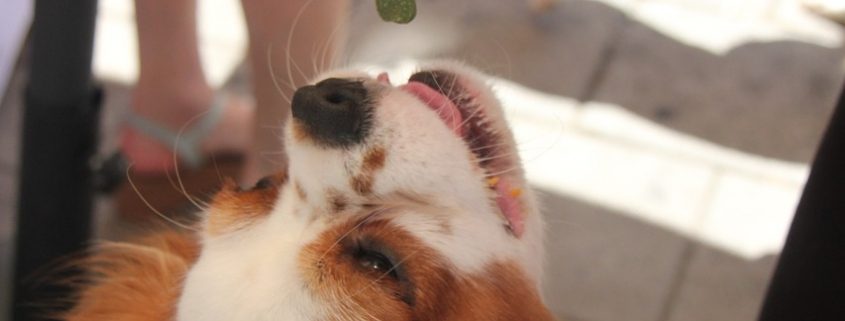Ask Crystal: Nature vs Nurture-Puppy Edition
Welcome to “Ask Crystal,” where you can ask your pet behavior questions! You can submit your question for Crystal at the bottom of the page!

Dear Crystal,
I recently got a cocker spaniel pup. He is cocker number five owned over the last 30 years. The first two days home he was cuddly and very well behaved. He has adjusted to our home fine, however he has started to get snappy and growls which scares me. This happens often times when we pick him up or while being held. Cocker number one had an aggressive behavior, so I am aware of what that is like. I was told by my vet that he is trying to be an alpha male with my husband and myself, and was given a few tips. I do need to add that we do have a 9 yr old cocker who does not care for him. The older cocker growls and sometimes snaps at him. Is the pup picking this behavior up from the older dog? I need help please.
Sincerely,
Worried Puppy Mom
Dear Worried,
Congrats on your new addition! I certainly understand how stressful adding a new puppy is since I am also a new puppy mom. We don’t really expect puppies to show aggressive behaviors such as growling or snapping but it is something that happens with some puppies.
There is some controversy as to how much of a dog’s behavior is nature vs nurture. Naturally as in all things, there are strong believers on both sides of the issue. There are many like me who believe it is a combination of both factors, although I can’t say in what percentage it might be. My personal experience leads me to believe that genetics weigh heavily, and we can help skew things one way or another with nurture, but it depends on how severe the issue is.
I do see some dogs that seem fine the first couple days after adoption and then their behavior deteriorates. It could be that the dog was overwhelmed the first couple days and suppressing behaviors. It could also be that the puppy is experiencing a high level of stress from the move to the new home and the other dog not behaving friendly towards him. When dogs experience stress, their bodies produce chemicals such as adrenaline and cortisol which build up in their bodies. If the dog’s body is not given time away from stressors to allow their body chemicals to go back to normal, they experience what we call trigger stacking. This means that the dog is more reactive to stressors than they normally would be because of the buildup of stress in their body.
Humans experience trigger stacking as well. Imagine you just had a relaxing day at the spa and on the way home you stop to get a coffee. As the barista hands you the coffee, you lose your grip and the coffee spills on your new pants. You might be a bit bothered but you would likely just wipe it off and move on. Then imagine that you woke up late for work, you are rushing out the door, you trip on a dog’s toy, hit your knee on the table. You stop and get that coffee and get the coffee spilled on your lap. Do you think in that scenario you could just wipe it off and move on? If it were me, I can guarantee I would be much more upset in the second scenario. That is what a new dog is going through but on a much larger scale.
Your puppy most likely has some discomfort with handling. It is not completely uncommon. Dogs and humans have very different ways of interacting with each other. Humans are primates so we are very handsy. We have to touch everything with our hands, pick it up, hug it, kiss it, etc. Dogs do not hug each other. Most puppies tolerate the handling even if they don’t necessarily like it so a lot of people just keep on hugging the puppy without knowing that the puppy is not enjoying it.
 We want to teach our puppies that human touch makes good things happen. We do this by pairing touch that the puppy is comfortable with something valuable to them like yummy treats. We need to figure out where he is completely comfortable and start there. As you work with him you will slowly be able to do more and more handling. At this point, we need to avoid all restraint and touching that he is uncomfortable with if at all possible. Of course, sometimes we need to do certain things, but you can probably figure out how to do most of what you need to without picking him up and you don’t need to be holding him in most cases.
We want to teach our puppies that human touch makes good things happen. We do this by pairing touch that the puppy is comfortable with something valuable to them like yummy treats. We need to figure out where he is completely comfortable and start there. As you work with him you will slowly be able to do more and more handling. At this point, we need to avoid all restraint and touching that he is uncomfortable with if at all possible. Of course, sometimes we need to do certain things, but you can probably figure out how to do most of what you need to without picking him up and you don’t need to be holding him in most cases.
Before getting started, we need to make sure that we are able to read a dog’s body language so that we can see when the dog is trying to communicate discomfort. Usually, but not always there are a lot of subtler signals that come before the dog feels the need to growl and snap. Most people are unaware of these signals and continue doing whatever it is that is making the dog uncomfortable. The dog then feels that they must resort to larger, more aggressive threats since the less threatening signals are being ignored.
Some examples of signals of discomfort a puppy or dog might show; turning their head away from you, looking away from you, trying to playful wiggle away, licking your arms or hands, moving away as soon as they have the chance, becoming tense, mouthing your hand or arm.
I really like the 3 second test for petting to gauge if a dog actually wants to be petted. Sit next to the dog, hold your hand out and touch in a nonthreatening location for 3 seconds and then stop with your hand down. What does the dog do after you stop? Do they turn or move away? That means they want to disengage. Do they move towards you softly? Do they nudge your hand? You can get to know your dog’s personal signals to indicate that they want more interaction. In this way, we build trust by showing the dog we understand them and respect their wishes.
Knowing how to read his subtle signals will help you determine where you can start touching him so that he is completely comfortable. That place may be on the side of his neck or his back depending on the individual dog. Touch and treat and repeat until the dog gets a happy look on his face when you touch him. That means he is making the connection between being touched and receiving a treat. When you are consistently getting that response, move on to touching parts of the body that he may be a little less comfortable with. That could be his paws, ears or belly. You always want to make sure you are getting that happy response to your touch before moving on to another spot. He is pulls away or shows signs of discomfort, you moved too fast, and you need to back up to where he is comfortable.
To desensitize and counter condition him to being picked up, you need to break the behavior down into very small parts so that you can start where he is comfortable. You could start with him on the couch next to you. Hopefully, you have already done some of the handling work so that he is comfortable with your touch. Start by moving your hand around him where you would pick him up but without touching him and treat. Next, do the same thing but briefly touch him and treat. The next step is touching him with more pressure and then extending the duration of the touch. Next, he may be ready for a very quickly short lift and treat. Be sure that you are giving the special treat while he is in your arms not after you put him down. Some dogs do better if they have a verbal cue where the person tells them that they are going to pick them up so it’s not a surprise. You could say, “up” and pick him up, treat and put him down. Repeat until he gets excited to be picked up. This could take weeks or months, depending on the dog.
When he gets to where he is wiggling and excited to be picked up, you can pick up and hold for several seconds, treat and put down. Be sure you are paying attention to his signals. The goal is to set him down before he wants to be put down, so we haven’t pushed him too far.
I seriously caution against attributing his behavior to any sort of dominance related behavior. The definition of dominance is priority access to limited resources. There is no relationship to resources here. Furthermore, dominance is a fluid relationship between dogs, not dogs and humans. It is based on what the dog values and is willing to stand up to keep his access to it. This type of thinking causes an adversarial relationship between humans and dogs. The humans think the dog is trying to dominate them, so they use forceful methods to correct the dog. This damages the trust the dog has in you and the behavior is in fact fear based and using harsh methods will simply make the dog more fearful and the behavior problems worse.
Any time a dog is showing aggression it is best to have a trainer come out and observe the dog and create a specialized plan for you and your dog. They will be able to point out your dog’s signals and help you troubleshoot a plan. There is a strong likelihood that this puppy may have more behavioral problems down the road as well so having that relationship and guidance will be critical. Locate a trainer here.
I hope these tips help you to better understand your puppy and what is most likely to be going on with him. I can understand that it can be scary, but it sounds like you have a good idea what his triggers are and some ideas for how you can start working on it. Good luck!
Until next time,
Crystal







